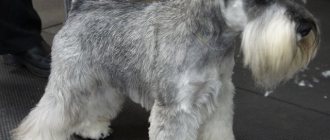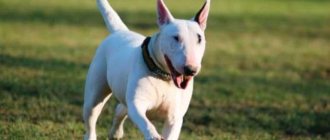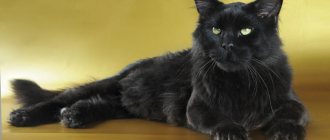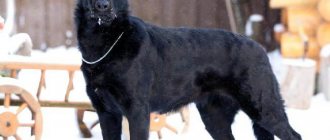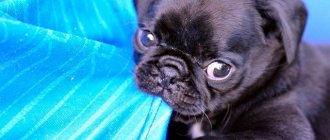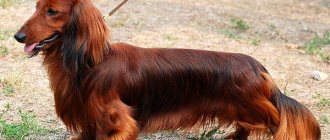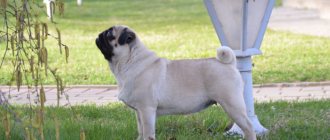What colors of French bulldog are there?
Along with the accepted standard and colors considered a breed defect, there are varieties of color that fall into the category of acceptable. After strict testing and evaluation by experts, black and brindle bulldogs can be allowed to compete. The dog looks black in appearance, but upon closer inspection, interspersed with red hairs are noticeable. The main feature of this type of color is the predominance of charcoal color and the brightness of red inclusions.
Unlike the FCI and RKF, the American Kennel Club recognizes the rare blue French bulldog, despite the fact that it is a lighter tone of gray with a silver tint.
Gray (ash)
Gray color comes in different shades - from light to classic mouse and steel. There are Frenchies with wool of a single color, with a slight tan or even a white spot on the chest. Most often the coat is short and shiny.
Black
Black color is not included in the breed standard. Variations and degrees of intensity appear depending on the genetic characteristics of the French. Dogs can be:
- dark;
- black and tan;
- spotted.
Black bulldogs with a white chest, neck or toes on their paws look especially elegant and beautiful.
Ginger
Red-colored dogs are a special case of fawn color, so they are accepted at exhibitions and competitions. It is acceptable to have light fawn spots on the body, except for the chest, neck and belly. Red necessarily remains the main background, against which there may be a dark mask and markings over the entire surface of the body.
Brown
Previously, brown color was included in the breed standard. Today, animals with this color are considered a defect, and their participation in exhibitions is impossible. The shades of color are varied - from dark and bright to light, pastel tones. Bulldogs may have longitudinal stripe markings and a mask on their face.
Chocolate
There are many options for chocolate color. Classic – brown-brown with a pronounced shine. A distinctive feature of chocolate is its uniform color. The color was artificially bred by breeders and is considered a defect in the breed. If she is classified as brindle or fawn, the standard is recognized.
Lilac
One of the rare colored coats of bulldogs is purple or lilac. Most often, such individuals are obtained by breeders living in the western United States of America. A light purple tint makes the Frenchie unusual and attractive. Options for purple color are varied - from cold blue to dark purple with a silver tint. There may be light markings on the chest and muzzle. A special feature of lilac bulldogs is their light eye color from birth and throughout their lives.
Sable
Sable color is rare. The Franz's coat looks like fawn, but with darker hairs throughout the surface. Some dogs have a creamy base color. The sable color is non-standard, the length of the dark hairs is different. They are especially clearly visible in puppies. In the first weeks the hairs are grayish, and later they turn red. In most cases, sable French Bulldogs have a dark mask on their face.
Marble
Despite the fact that marbled bulldogs are in great demand, breeding them is prohibited. The gene that provides color is dominant and is passed on to subsequent generations along with hereditary diseases. The main background of the coat of French bulldogs can be dark, almost black, brown, red or light. Spots or stripes of different colors and shapes are unevenly distributed across it. Marble puppies are often born with heterochromia.
Spotted
Spotted bulldogs are called white and fawn. The main color is white, and on it there are spots of brindle or brown. Intensity has several types:
- Medium spotting - white and brown markings are evenly distributed, another name is mantle coloring.
- Limited spotting - black with white tie.
- Absorbing - can be white-brindle with a predominance of light coat.
Merle
Merle or merle is similar to merle. Not included in the breed standard. Characterized by the presence of blurry, indistinct spots of different sizes and shades (white, brown, coffee). There is no mask on the face.
Tan
The peculiarity of the tan color is marks on the paws, above the eyes, on the chest, on the cheekbones, and under the tail. They have a contrasting color in relation to the main one.
Yellow (sand)
The pigment of a bulldog's coat with a yellow color is called golden. It is brighter than beige and fawn. The ears, chest, back of the paws, and belly have a lighter shade.
Faun
The fawn color is a variety of fawn, including red, orange, and café au lait. The most beautiful bulldogs are those with a black mask on their faces.
Pale yellow
The fawn color combines several shades:
- cappuccino;
- red;
- brown;
- wheat
The accepted breed standard allows for spots on the belly, forehead and chest. Their location in other places is considered a defect. A common variant of the Frenchie is fawn with black and white splashes or tiger stripes. The dog's belly is always milky white. The peculiarity of the color of the puppies is red hairs. Later, the long ones will become lighter, the short ones will darken.
Beige
The beige color of bulldogs resembles fawn, the difference is in the color of the lips, eyelids and nose. The first ones are cream, the second ones are black. Beige bulldogs are born with red fur. Gradually it brightens. The color is recognized as a standard only in the USA.
History of the origin of the breed
The Frenchman comes from bulldogs from England and Spain, and a separate breed was developed in the 18th century. The appearance of purebred dogs in Great Britain is associated with the fact that at that time bloody dog fights flourished, which required the appearance of a small fighting individual. The positive side was that the owner could easily transport the pet in his arms. After some time, the dogs found their way into the homes of the French elite. Then the breed was officially registered in France, and the dog was first introduced in 1896.
In the twentieth century, French bulldogs became desirable pets for the Russian elite. Between 1941 and 1945, the fashionable breed gradually disappeared from Russian territory. The animal population began to be restored only in the 50s of the twentieth century.
Rare coat colors
To obtain new exotic shades, dog breeders carry out breeding work. White, red, cream, blue, and two-colored individuals are extremely rare. Not all of them are allowed for further breeding due to being outside the standard.
Red
Red is a variety of fawn with a rich red tint. Belongs to the elite group and is valued by dog handlers. The cost of red Frenchies is high.
Cream
Cream dogs are a type of beige with a light nose and lips. There is no mask on the face, the color of the coat is close to white. The suit is not recognized by the International Canine Federation.
White
Pure white French Bulldogs are rare. Sometimes puppies are born light-colored, but after some time they turn into brindle. A common option is white with red spots. The markings can be any color, including a dark mask on the face. The exception is white dogs with black spots.
Blue
Blue French bulldogs are most often called blue to emphasize the unusualness of their color. This is a type of gray with a rich, silvery tint. The coat is beautiful, rare, but not recognized by the breed standard.
Black and white
Bicolor combines two colors – black and white. Each of them can act as the main one. The standard allows two-color coloring if the spots are located on the head, back and sides. The total area of the marks does not exceed 20% of the dog's body surface.
Albino
Albinos among French bulldogs are as rare as among other breeds. They inherit the corresponding genes from two parents. A pure albino has no pigmentation of the nose, mucous membranes or paw pads. Their eyes are pink, blue or light amber. The skin is transparent, blood vessels are visible through it. This species is considered a genetic disorder.
How do puppies change as they age?
When choosing a puppy, it is important to remember that newborn bulldogs have colors that will change with age. The main color is visible immediately, but it is possible to understand whether the dog will meet all breed standards only after some time. By two months, spots and other marks will already be clearly visible on the body. By six months, the puppy will have developed body contour and muscle mass. By 7 months, a mask on the face will appear (if present). And only by 11 months the color will be clearly expressed and will become close to the color with which the bulldog will live its entire life.
If a puppy is acquired from purebred parents, then you can understand its color based on its pedigree. The breeder will show all relevant documents guaranteeing that the puppy was born from parents without dominant blue, lilac genes.
Genetic factors affecting color
Genetic features determine not only the color of the bulldog, but also the intensity of the color:
- Two fawn or red Frenchies will not produce brindle puppies. From such a combination you can only get the corresponding colors.
- Two brindle bulldogs can produce fawn puppies, but only if both dogs are carriers of the fawn gene (that is, one of the parents was fawn). Theoretically, from such a mating the litter will be 25% fawn, 50% brindle with the fawn gene, 50% brindle without the fawn gene.
- Two spotted bulldogs will not produce solid colored puppies.
- Solid-colored dogs can get spotted-colored puppies if both parents had ancestors of the same color.
Life expectancy and health
Mixed breeds usually vary in life expectancy. Sometimes some genetic changes can weaken it and make it less resistant to disease. But it happens that the dog becomes stronger and healthier than ordinary French bulldogs.
IMPORTANT!
As a rule, the French live up to 10 years. Sometimes this limit reaches 12 years.
There are cases where, with proper care, regular prevention and treatment, Frenchies lived up to 15 years.
Diseases
that affect fawn bulldogs :
- Eye problems, vision loss, conjunctivitis, eye loss.
- Dermatitis, allergic skin reactions.
- Problems with the spine, it happens that bulldogs are paralyzed or their hind legs fail.
- Breathing problems. It is difficult to tolerate heat and stuffiness.
- Ear problems. You need to carefully care for the ear, or the dog may suffer from otitis media.
- Difficult birth. Often a bulldog mother dies during childbirth. Pregnancy must be monitored carefully, and childbirth must be delivered by a professional.
- Obesity. It is important to feed your pet properly.
Character of dogs
French bulldogs are distinguished by their pronounced ability to adopt the personality traits of their owners.
General characteristics of the breed :
- mobility;
- physical endurance;
- intelligence.
Dogs of this breed are trainable , but they learn slowly.
The French Bulldog is unobtrusive, but does not tolerate loneliness well, and by temperament is a companion dog. Representatives of the breed have a highly developed maternal instinct.
IMPORTANT!
French bulldogs have a calm disposition, but they need good upbringing; in the absence of it, they can show aggression both towards other animals and people, and towards members of their own family.
